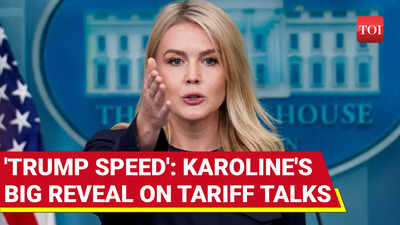- News
- World News
- US News
- Trump signals tariff rollback on China- What changed
Trending
Trump signals tariff rollback on China- What changed
Donald Trump hinted at reducing the 145% tariffs on Chinese imports, acknowledging their unsustainability while insisting on a trade deal. This shift follows financial market turmoil, Chinese retaliation, and domestic pressures from businesses and consumers. Treasury Secretary Bessent's warnings and internal political tensions also influenced Trump's softened stance, though he maintained tariffs wouldn't return to zero.
US president Donald Trump suggested on Wednesday that the 145% tariffs he imposed on Chinese imports will not last.
Speaking from the Oval Office on Tuesday, Trump told reporters the tariff rate would eventually "come down substantially." He acknowledged that the current rate was unsustainable but emphasised that it would not return to the “zero” levels it once was.
“145% is very high, and it won't be that high,” Trump remarked. However, he reiterated his position that a trade deal with China was crucial, saying, "Ultimately, they have to make a deal because otherwise they're not going to be able to deal in the United States."
Chinese imports are currently subject to a 145% tariff by US. In retaliation, China imposed 125% tariffs on US exports.
Reasons for Trump’s changed stance
- Market turmoil: One of the primary catalysts for Trump’s change in stance is the significant turmoil in financial markets. The initial imposition of steep tariffs led to a global market sell-off, causing a major drop in stock market value and surging bond yields. This volatility, described as the most intense since the Covid-19 pandemic, seemed to prompt Trump to reconsider the effectiveness of such an aggressive approach.
Chinese retaliation : China’s swift and robust countermeasures, such as the retaliatory 125% tariffs on US exports and strategic cooperation with countries like Vietnam, South Korea, and the EU, undercut the effectiveness of the high US tariffs. China's diplomatic effort signaled its readiness for a prolonged trade war, pushing the US to reassess its strategy.- Domestic pressure: On the domestic front, US businesses and consumers began to feel the strain of the tariffs. Supply chain disruptions, including canceled freight orders and abandoned shipments, compounded the pressure on the administration. This created a growing sense of urgency to find a resolution before further damage was done to the US economy.
- Internal criticism: Bipartisan opposition to the tariffs, combined with instances such as public disputes between trade advisor Peter Navarro and Elon Musk, may have contributed to the growing pressure to reconsider the tariff strategy.
- Warnings from Bessent: Trump's statement came immediately after Treasury Secretary Scott Bessent reportedly warned that the current trade standoff was untenable. His remarks at a private JP Morgan Chase event, where he described the trade status quo as unsustainable, appeared to be a turning point for Trump in softening his stance.

About the Author
TOI World DeskEnd of Article
Follow Us On Social Media









